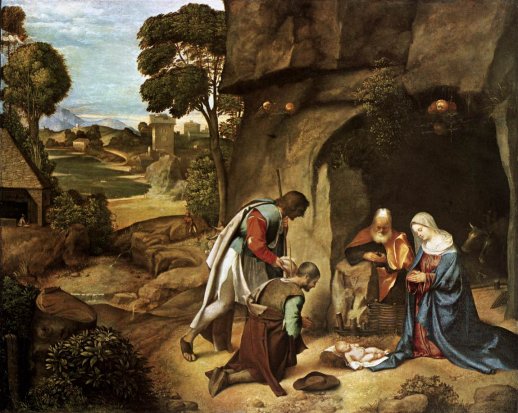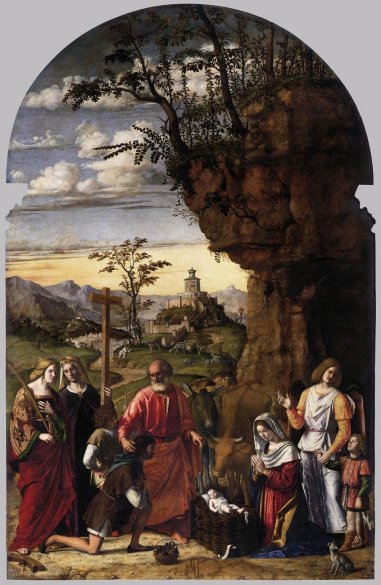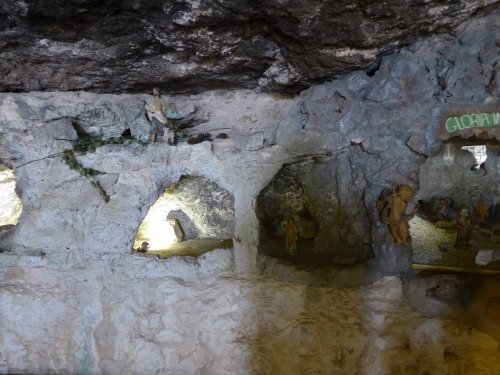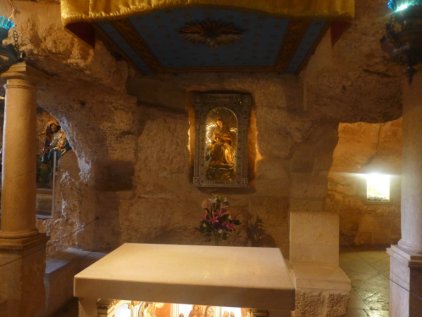This extra page on the Nativity follows a discussion with my good friend and blogger Frank de Stefano. Here is his updated page on the Nativity by Giorgione:
https://giorgionetempesta.blogspot.com/2019/12/giorgione-adoration-of-shepherds.html
His thoughts on the adoration of the Christ Child as a representation of the first Eucharist and the hard ground/stone as altar are explained very clearly. A fine analysis. What is perhaps unusual for a painting of this period is the depiction of a cave rather than a stable, though Botticelli returned to the idea in His Mystic Nativity. This seems to hark back to much earlier art.
So why a cave? A visit to Bethlehem a few years ago provoked thoughts in this, and I'll discuss this below. First, I was intrigued by the similariries between the Giorgione and another Venetian artwork painted very close in time shown below, by Cima da Conegliano.


This was painted for the Chiesa dei Carmini
in Venice, where it still is. The web Gallery of Art gives dates of 1509
– 10 for this – pretty well the same date as for the Giorgione.
The similarities are striking, though
Cima’s painting isn’t as good, and he includes some odd characters –
what are Tobit and his fish and that archangel doing there? Both
paintings have a couple of odd characters in the background, though one
in the Cima is somewhat out of scale. Are they the shepherds at an
earlier moment?
What stands out for me in the Cima is the octagonal building in the background – I’m fairly certain this is the Holy Sepulchre, often depicted like this. Is there a suggestion of distant Jerusalem in the Giorgione?


Now on to our visit to Belthlehem.
Our first port of call was to the
Shepherds’ field. There is a roomy cave there, now a chapel. Our guide
told us that caves were the usual shelter for shepherds and their sheep
– stables as such were a much later idea.
The Grotto of the Nativity in Bethlehem is below
ground level, though whether originally a cave was involved is not
clear. Another interesting Bethlehem church, the Grotto of the Milk, was
where according to tradition the Holy Family sheltered during the
Massacre of the Innocents.
Venice was an important
stopping place for Holy Land pilgrims at the time, which Florence
wasn’t. The Church of the Nativity, the Shepherds’ fields and – I think
significantly – the Holy Sepulchre were largely in the care of
Franciscans, who had an important presence in Venice at this time. Could
this be the basis of the tradition?
So what about the Holy Sepulchre? The tomb of
Christ was a cave too, and I wonder if this is implied in the painting.
I wrote about this on my pages on the entombment – A cave behind, and
often an altar-like sarcophagus in front with the dead Christ on it.
Another Eucharistic image.

Cave of the Shepherds

Grotto of the Holy Milk
Nativity Index
Home page Life of the Virgin Index